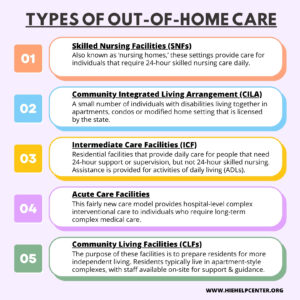 In most cases, children with cerebral palsy and hypoxic-ischemic encephalopathy are cared for in a home environment. It is very rare that children are placed in an out-of-home environment as minors. Many more resources are available to help families obtain the resources needed to make their own home accessible and safe.
In most cases, children with cerebral palsy and hypoxic-ischemic encephalopathy are cared for in a home environment. It is very rare that children are placed in an out-of-home environment as minors. Many more resources are available to help families obtain the resources needed to make their own home accessible and safe.
Families overwhelmingly reported that home care for their child produced better outcomes both for the individual and for the family unit as a whole. Furthermore, the employment of the medical home model for children with disabilities has made it easier to obtain patient-centered medical care and provide needed services to a child with more complex medical needs.
How often is out-of-home care utilized?
In exceptionally rare cases, children with disabilities can be placed in out-of-home care if their parents do not have the resources or community support to safely care for their child. This occurs in fewer than 5% of cases in the United States.
Once the children are no longer minors, their housing options diversify somewhat. In some cases, individuals stay in their parents’ residences. In other cases, they may move into a supported housing environment with individualized residential supports where they can live semi-independently. Current trends in disability discourse support the funding of community-based programs, especially as these programs most often adhere to the concept of ‘least restrictive environment,’ which some other facilities do not share.
Where does the funding come from?
Funding is variable and can depend on the availability of waivers and individual state programs. One resource for finding available housing arrangements is the Care Lookup website. Care Lookup provides information regarding a wide variety of continuing care arrangements, including intermediate care centers and other options. Living Arrangements for the Developmentally Disabled, Inc., is another a nonprofit group that seeks to provide housing for individuals with developmental disabilities.
Types of Out-of-Home Care
While the following options are rarely utilized for the care of minors with intellectual or developmental disabilities, these options do exist and may still be useful in a very small and specific subset of cases:

Skilled nursing facilities
Skilled nursing facilities (SNFs) or skilled nursing facilities for developmental disabilities (SNF/DDs) are known as ‘nursing homes.’ These settings provide care for individuals that require 24-hour skilled nursing daily. Pediatric SNFs focus on caring for a population of young individuals (children and young adults) with complex medical problems; many of these individuals have intellectual and/or developmental disabilities (I/DD). These facilities sometimes also provide respite care on a temporary basis. Standards and services provided in these environments can vary significantly depending on the state.
Community Integrated Living Arrangement (CILA)
A CILA is a service arrangement for individuals with developmental disabilities that focuses on the service needs of the individual within his or her home or community. CILAs are made up of a small number of disabled individuals who live together in an apartment, condominium or modified home setting. They must be licensed by the State. Group residences (as described below) are one example of a CILA.
Group residences/medical group homes
Care settings where a group of eight or fewer individuals with intellectual or developmental disabilities live together in a home-like setting under the supervision of licensed professionals who can assist with certain tasks. These settings are usually adapted single-family homes housed within a residential neighborhood. Admission is regulated into these facilities.
Intermediate care facilities for people with developmental disabilities (ICF/DD)
These are typically residential facilities that provide daily care for individuals that may need 24-hour support or supervision, but do not require 24-hr. skilled nursing. Typically, assistance is provided with the activities of daily living (ADLs). ICF/DDs may be in a nursing home setting, in small individual homes on a specific campus or in a dorm-style residence.
Acute care facilities
This fairly new care model provides hospital-level complex interventional care to individuals who require long-term complex medical care. Treatments include mechanical ventilator management with frequent adjustments, frequent medication changes, parenteral fluids, dialysis, complex wound care, and other interventions.
Residential schools
Some children and adolescents are placed in residential schools which provide expertise and specific curriculum adjustments for individuals with specific disabilities. Some focus on behavioral or psychiatric difficulties, while others focus on physical disabilities. Usually, children return home during vacations.
Community Living Facilities (CLFs)
These facilities are for individuals who need support and guidance in many of the areas related to the activities of daily living but do not require constant supervision. The purpose of these facilities is to prepare residents for more independent living. Residents typically live in apartment-style complexes, with staff available on-site.
Enhanced foster care
A very uncommon option used only in situations where parents are unable to provide care to their children. Enhanced foster care provides a home for children with disabilities on a temporary basis.
Related Resources
